Slotted Circular-Patch MIMO Antenna for 5G Applications at Sub-6 GHz
Abstract
1. Introduction
2. Evolution of Single Antenna Element
2.1. Antenna Design
2.2. Performance and Discussion
2.3. Performance Analysis
2.4. Performance Comparison of the Single Antenna with Previous Works
3. A 2-Port MIMO System Using Two Flipped Parallel 1 × 2 Arrays Antenna
3.1. Design of (1 × 2) Antenna Array Arrangement
3.2. Design of a 2-Port MIMO System Using Two Flipped Parallel 1 × 2 Arrays Arrangement
3.3. Measurement Results Discussion of Two 1 × 2 Arrays MIMO
3.3.1. Reflection, Transmission Coefficients, Radiation Pattern, and Gain Results
3.3.2. MIMO Performance Results of Two 1 × 2 Arrays MIMO
3.4. Performance Comparison of Two 1 × 2 Arrays MIMO with Previous Works
4. A 2-Port MIMO System Using Two Opposite 1 × 4 Antenna Arrays
4.1. Design of (1 × 4) Antenna Array Arrangement
4.2. Design of 2-Port MIMO System Using Two Opposite 1 × 4 Arrays Arrangement
4.3. Measurement Results Discussion of Two 1 × 4 Arrays MIMO
4.3.1. Reflection, Transmission Coefficients, Radiation Pattern, and Gain Results
4.3.2. MIMO Performance Results of Two 1 × 4 Arrays MIMO
4.4. Performance Comparison of Two 1 × 4 Arrays MIMO with Previous Works
5. Experimental Testing of the Proposed Antennas Within the 5G MIMO Application Framework
6. Conclusions
Author Contributions
Funding
Data Availability Statement
Acknowledgments
Conflicts of Interest
References
- Tiwari, R.N.; Thirumalaiah, R.; Naidu, V.R.; Sreenivasulu, G.; Singh, P.; Rajasekaran, S. Compact dual-band 4-port MIMO antenna for 5 G-sub 6 GHz/N38/N41/N90 and WLAN frequency bands. AEU-Int. J. Electron. Commun. 2023, 171, 154919. [Google Scholar] [CrossRef]
- Din, I.U.; Alibakhshikenari, M.; Virdee, B.S.; Ullah, S.; Ullah, S.; Akram, M.R.; Ali, S.M.; Livreri, P.; Limiti, E. High-performance antenna system in MIMO configuration for 5G wireless communications over sub-6 GHz spectrum. Radio Sci. 2023, 58, 1–22. [Google Scholar] [CrossRef]
- Tulum, M.A.; Turk, A.S.; Mahouti, P. Data-driven surrogate modeling of phase array antennas using deep learning for millimetric band applications. IEEE Access 2023, 11, 114415–114423. [Google Scholar] [CrossRef]
- Van Messem, L.; Moerman, A.; Caytan, O.; de Paula, I.L.; Hoflack, B.; Stroobandt, B.; Lemey, S.; Moeneclaey, M.; Rogier, H. A 4 × 4 millimeter-wave-frequency Butler matrix in grounded co-planar waveguide technology for compact integration with 5G antenna arrays. IEEE Trans. Microw. Theory Tech. 2022, 71, 122–134. [Google Scholar] [CrossRef]
- Azim, R.; Aktar, R.; Siddique, A.K.M.M.H.; Paul, L.C.; Islam, M.T. Circular patch planar ultra-wideband antenna for 5G sub-6 GHz wireless communication applications. J. Optoelectron. Adv. Mater. 2021, 23, 127–133. [Google Scholar]
- Shamoon, S.; Zhou, W.Y.; Shahzad, F.; Ali, W.; Subbyal, H. Integrated sub-6 GHz and millimeter wave band antenna array modules for 5G smartphone applications. AEU-Int. J. Electron. Commun. 2023, 161, 154542. [Google Scholar] [CrossRef]
- Khorasani, S.A.; Zakeri, H.; Moradi, G.; Alibakhshikenari, M.; See, C.H.; Limiti, E. Orbital angular momentum with the approach of using in sub-6GHz 5G mobile communications for wireless applications. In Proceedings of the 2024 6th Global Power, Energy and Communication Conference (GPECOM), Budapest, Hungary, 4–7 June 2024; pp. 1–4. [Google Scholar]
- Zakeri, H.; Shirazi, R.S.; Moradi, G. An accurate model to estimate 5g propagation path loss for the indoor environment. arXiv 2023, arXiv:2302.10057. [Google Scholar] [CrossRef]
- Jayaprakash, V.; Chandu, D.S.; Barik, R.K.; Koziel, S. Compact Substrate-Integrated Hexagonal Cavity-Backed Self-Hexaplexing Antenna for Sub-6 GHz Applications. IEEE Access 2024, 12, 54397–54404. [Google Scholar] [CrossRef]
- Mohanty, A.; Sahu, S. 4-port UWB MIMO antenna with Bluetooth-LTE-WiMax band-rejection and vias-MCP loaded reflector with improved performance. AEU-Int. J. Electron. Commun. 2022, 144, 154065. [Google Scholar] [CrossRef]
- Hu, K.; Zhou, Y.; Sitaraman, S.K.; Tentzeris, M.M. Additionally, manufactured flexible on-package phased array antennas for 5G/mmWave wearable and conformal digital twin and massive MIMO applications. Sci. Rep. 2023, 13, 12515. [Google Scholar]
- Mahto, S.K.; Singh, A.K.; Sinha, R.; Alibakhshikenari, M.; Khan, S.; Pau, G. Highly isolated four-element MIMO antenna for ISM/LTE/5G (Sub-6GHz) applications. IEEE Access 2023, 11, 82946–82959. [Google Scholar] [CrossRef]
- Liu, H.Y.; Huang, C.J. Wideband MIMO antenna array design for future mobile devices operating in the 5G NR frequency bands n77/n78/n79 and LTE band 46. IEEE Antennas Wirel. Propag. Lett. 2019, 19, 74–78. [Google Scholar]
- Thummaluru, S.R.; Ameen, M.; Chaudhary, R.K. Four-port MIMO cognitive radio system for midband 5G applications. IEEE Trans. Antennas Propag. 2019, 67, 5634–5645. [Google Scholar] [CrossRef]
- Kulkarni, J.S.; Sim, C.Y.D. Low-profile, multiband wideband ‘C-shaped’ monopole antenna for 5G and WLAN applications. In Proceedings of the 2020 International Conference on Radar, antenna, Microwave, Electronics, and Telecommunications (ICRAMET), Tangerang, Indonesia, 18–20 November 2020; pp. 366–371. [Google Scholar]
- Li, Y.; Zou, H.; Wang, M.; Peng, M.; Yang, G. Eight-element MIMO antenna array for 5G/Sub-6GHz indoor micro wireless access points. In Proceedings of the 2018 International Workshop on Antenna Technology (iWAT), Nanjing, China, 5–7 March 2018; pp. 1–4. [Google Scholar]
- Ren, Z.; Wu, S.; Zhao, A. Triple band MIMO antenna system for 5G mobile terminals. In Proceedings of the 2019 International Workshop on Antenna Technology (iWAT), Miami, FL, USA, 3–6 March 2019; pp. 163–165. [Google Scholar]
- Zhang, Y.M.; Zhang, S.; Li, J.L.; Pedersen, G.F. A transmission-line-based decoupling method for MIMO antenna arrays. IEEE Trans. Antennas Propag. 2019, 67, 3117–3131. [Google Scholar] [CrossRef]
- Al-Turjman, F.; Ever, E.; Zahmatkesh, H. Small cells in the forthcoming 5G/IoT: Traffic modelling and deployment overview. IEEE Commun. Surv. Tutor. 2018, 21, 28–65. [Google Scholar] [CrossRef]
- Hussain, R.; Raza, A.; Khan, M.U.; Shammim, A.; Sharawi, M.S. Miniaturized frequency reconfigurable pentagonal MIMO slot antenna for interweave CR applications. Int. J. RF Microw. Comput.-Aided Eng. 2019, 29, e21811. [Google Scholar] [CrossRef]
- Ta, S.X.; Nguyen, D.M.; Nguyen, K.K.; Dao-Ngoc, C.; Nguyen-Trong, N. A tripolarized antenna with ultrawide operational bandwidth. IEEE Trans. Antennas Propag. 2020, 68, 4386–4396. [Google Scholar] [CrossRef]
- Wong, K.L.; Chen, J.Z.; Li, W.Y. Four-port wideband annular-ring patch antenna generating four decoupled waves for 5G multi-input–multi-output access points. IEEE Trans. Antennas Propag. 2020, 69, 2946–2951. [Google Scholar] [CrossRef]
- Molins-Benlliure, J.; Antonino-Daviu, E.; Cabedo-Fabrés, M.; Ferrando-Bataller, M. Four-port wide-band cavity-backed antenna with isolating X-shaped block for sub-6 GHz 5G indoor base stations. IEEE Access 2021, 9, 80535–80545. [Google Scholar] [CrossRef]
- Zhang, E.; Michel, A.; Pino, M.R.; Nepa, P.; Qiu, J. A dual circularly polarized patch antenna with high isolation for MIMO WLAN applications. IEEE Access 2020, 8, 117833–117840. [Google Scholar] [CrossRef]
- Singhwal, S.S.; Kanaujia, B.K.; Singh, A.; Kishor, J.; Matekovits, L. Multiple-input multiple-output dielectric resonator antenna with circular polarized adaptability for 5G applications. J. Electromagn. Waves Appl. 2020, 34, 1180–1194. [Google Scholar] [CrossRef]
- Molins-Benlliure, J.; Cabedo-Fabrés, M.; Antonino-Daviu, E.; Ferrando-Bataller, M. Sector unit-cell methodology for the design of Sub-6 GHz 5G MIMO antennas. IEEE Access 2022, 10, 100824–100836. [Google Scholar] [CrossRef]
- Nahar, T.; Rawat, S.; Pathak, P.; Kumar, P.; Anguera, J. Leaf-shaped antennas for Sub-6 GHz 5G applications. IEEE Access 2024, 12, 114338–114357. [Google Scholar] [CrossRef]
- Zakeri, H.; Azizpour, R.; Khoddami, P.; Moradi, G.; Alibakhshikenari, M.; See, C.H.; Denidni, T.A.; Falcone, F.; Koziel, S.; Limiti, E. Low-cost multiband four-port phased array antenna for sub-6 GHz 5G applications with enhanced gain methodology in radio-over-fiber systems using modulation instability. IEEE Access 2024, 12, 117787–117799. [Google Scholar] [CrossRef]
- Khan, S.; Marwat, S.N.K.; Khan, M.A.; Ahmed, S.; Gohar, N.; Alim, M.E.; Algarni, A.D.; Elmannai, H. A Self-Decoupling Technique to Realize Dense Packing of Antenna Elements in MIMO Arrays for Wideband Sub-6 GHz Communication Systems. Sensors 2023, 23, 654. [Google Scholar] [CrossRef]
- Jin, G.; Deng, C.; Xu, Y.; Yang, J.; Liao, S. Differential frequency-reconfigurable antenna based on dipoles for sub-6 GHz 5G and WLAN applications. IEEE Antennas Wirel. Propag. Lett. 2020, 19, 472–476. [Google Scholar] [CrossRef]
- Liu, P.; Meng, Z.; Wang, L.; Zhang, Y.; Li, Y. Omnidirectional dual-polarized saber antenna with low wind drag. IEEE Trans. Antennas Propag. 2019, 68, 558–563. [Google Scholar] [CrossRef]
- Li, Q.L.; Cheung, S.W.; Wu, D.; Yuk, T.I. Optically transparent dual-band MIMO antenna using micro-metal mesh conductive film for WLAN system. IEEE Antennas Wirel. Propag. Lett. 2016, 16, 920–923. [Google Scholar] [CrossRef]
- Ameen, A.M.; Ahmed, M.I.; Elsadek, H.; Anis, W.R. Design of 4-direction MIMO Vivaldi antenna system for vehicle communication in 5G applications. J. Electromagn. Waves Appl. 2022, 36, 2027–2040. [Google Scholar] [CrossRef]
- Alharbi, A.G.; Rafique, U.; Ullah, S.; Khan, S.; Abbas, S.M.; Ali, E.M.; Alibakhshikenari, M.; Dalarsson, M. Novel MIMO antenna system for ultra-wideband applications. Appl. Sci. 2022, 12, 3684. [Google Scholar] [CrossRef]
- Ho Chae, S.; Il Kawk, W.; Park, S.O.; Lee, K. Analysis of mutual coupling in MIMO antenna array by TARC calculation. In Proceedings of the 2006 Asia-Pacific Microwave Conference, Yokohama, Japan, 12–15 December 2006; pp. 2090–2093. [Google Scholar]
- Fang, Y.; Jia, Y.; Zhu, J.Q.; Liu, Y.; An, J. Self-decoupling, shared-aperture, eight-antenna MIMO array with MIMO-SAR reduction. IEEE Trans. Antennas Propag. 2023, 72, 1905–1910. [Google Scholar] [CrossRef]
- Jiang, J.Y.; Su, H.L. A Wideband Eight-Element MIMO Antenna Array in 5G NR n77/78/79 and WLAN-5GHz Bands for 5G Smartphone Applications. Int. J. Antennas Propag. 2022, 2022, 8456936. [Google Scholar] [CrossRef]
- Kiani, S.H.; Savci, H.S.; Abubakar, H.S.; Parchin, N.O.; Rimli, H.; Hakim, B. Eight-element MIMO antenna array with tri-band response for modern smartphones. IEEE Access 2023, 11, 44244–44253. [Google Scholar] [CrossRef]
- Kulkarni, N.; Linus, R.M.; Bahadure, N.B. A small, wideband, inverted L-shaped flexible antenna for sub-6 GHz 5G applications. AEU-Int. J. Electron. Commun. 2023, 159, 154479. [Google Scholar] [CrossRef]
- John, D.M.; Vincent, S.; Pathan, S.; Shinde, K.D.; Supreetha, B.S.; Ali, T. Eight-Element Flexible MIMO Antenna Based on Characteristics Mode Theory with Enhanced Channel Capacity for Sub 6 GHz 5G Communications. Results Eng. 2025, 25, 104208. [Google Scholar] [CrossRef]

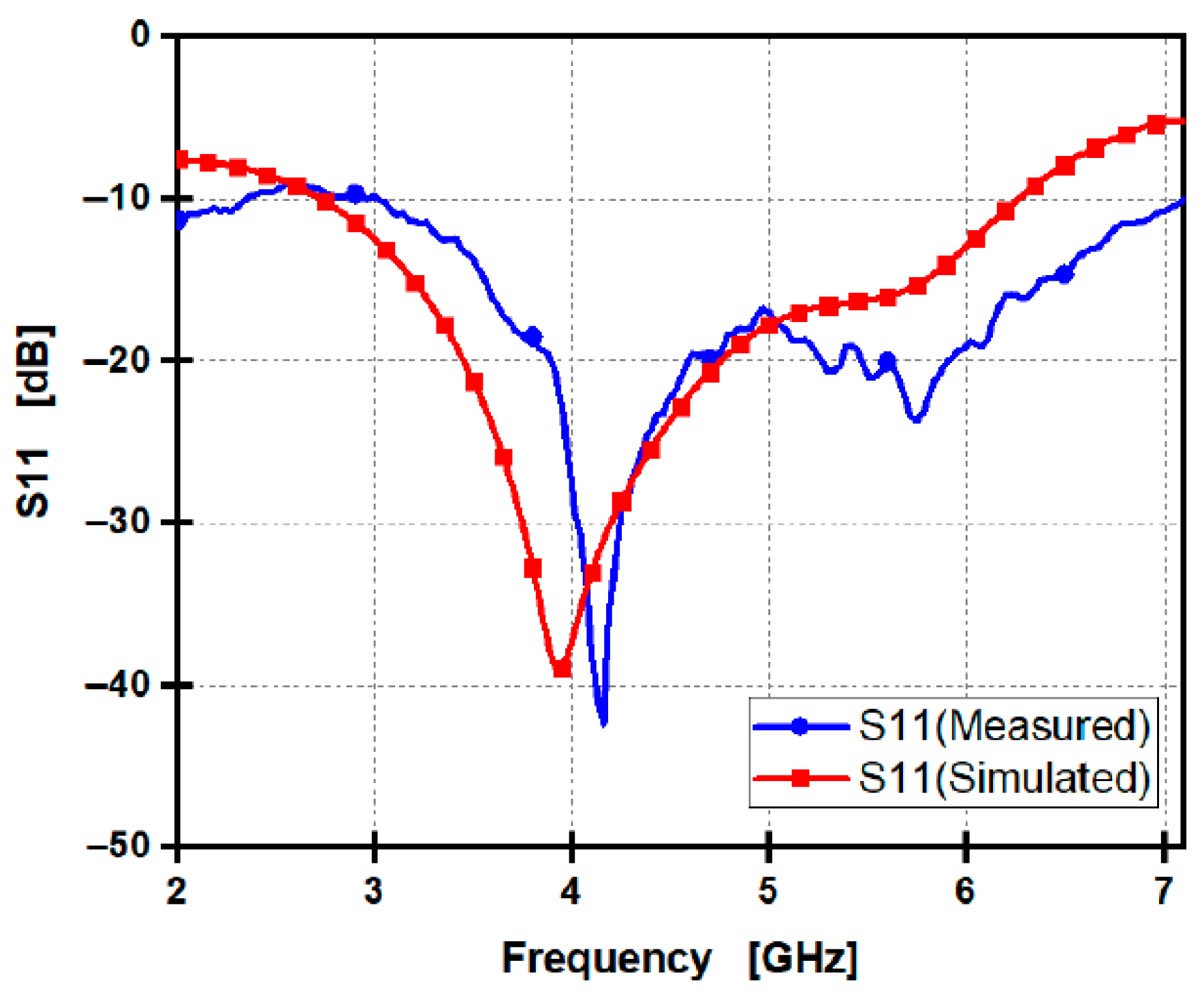


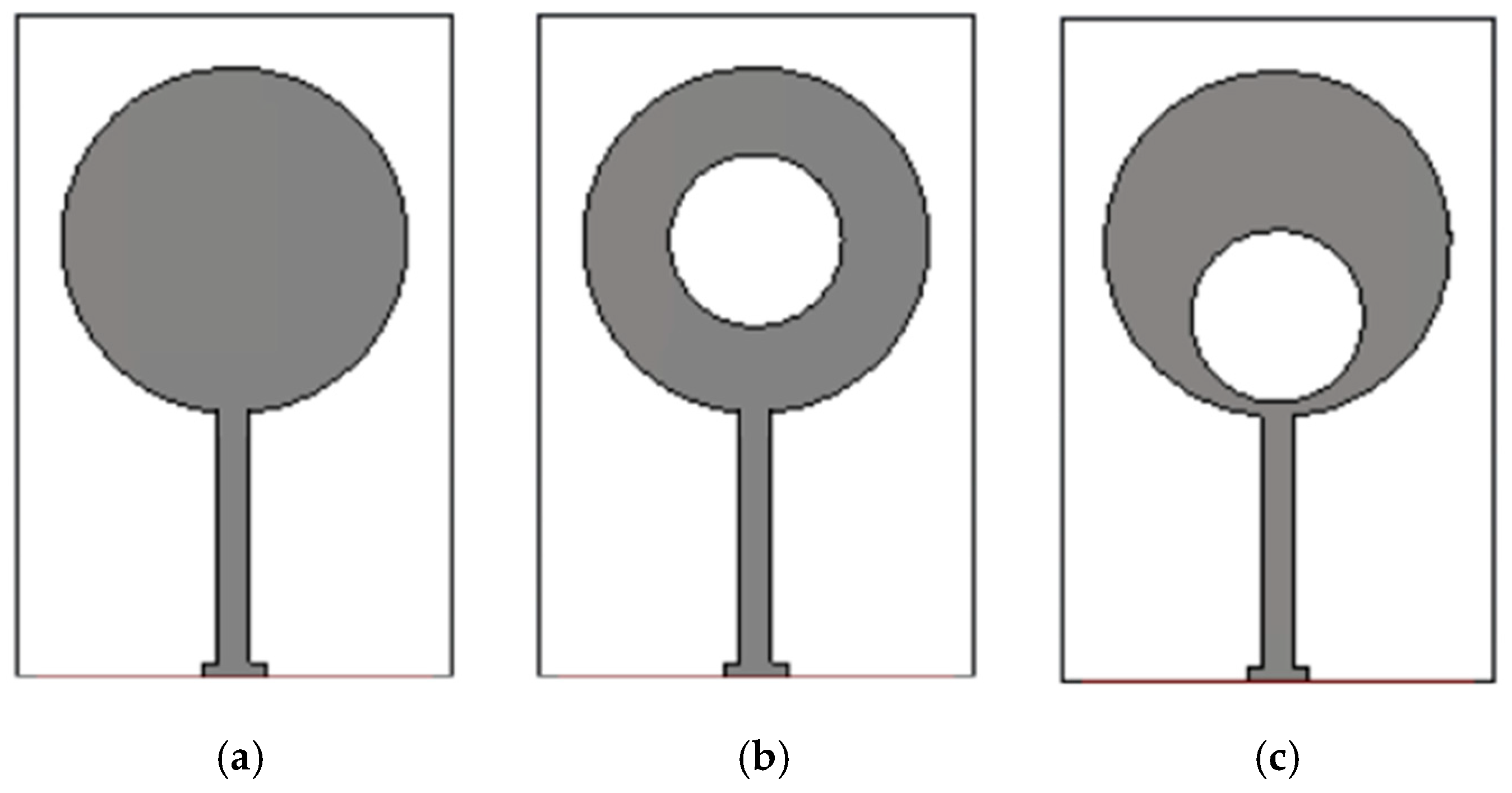
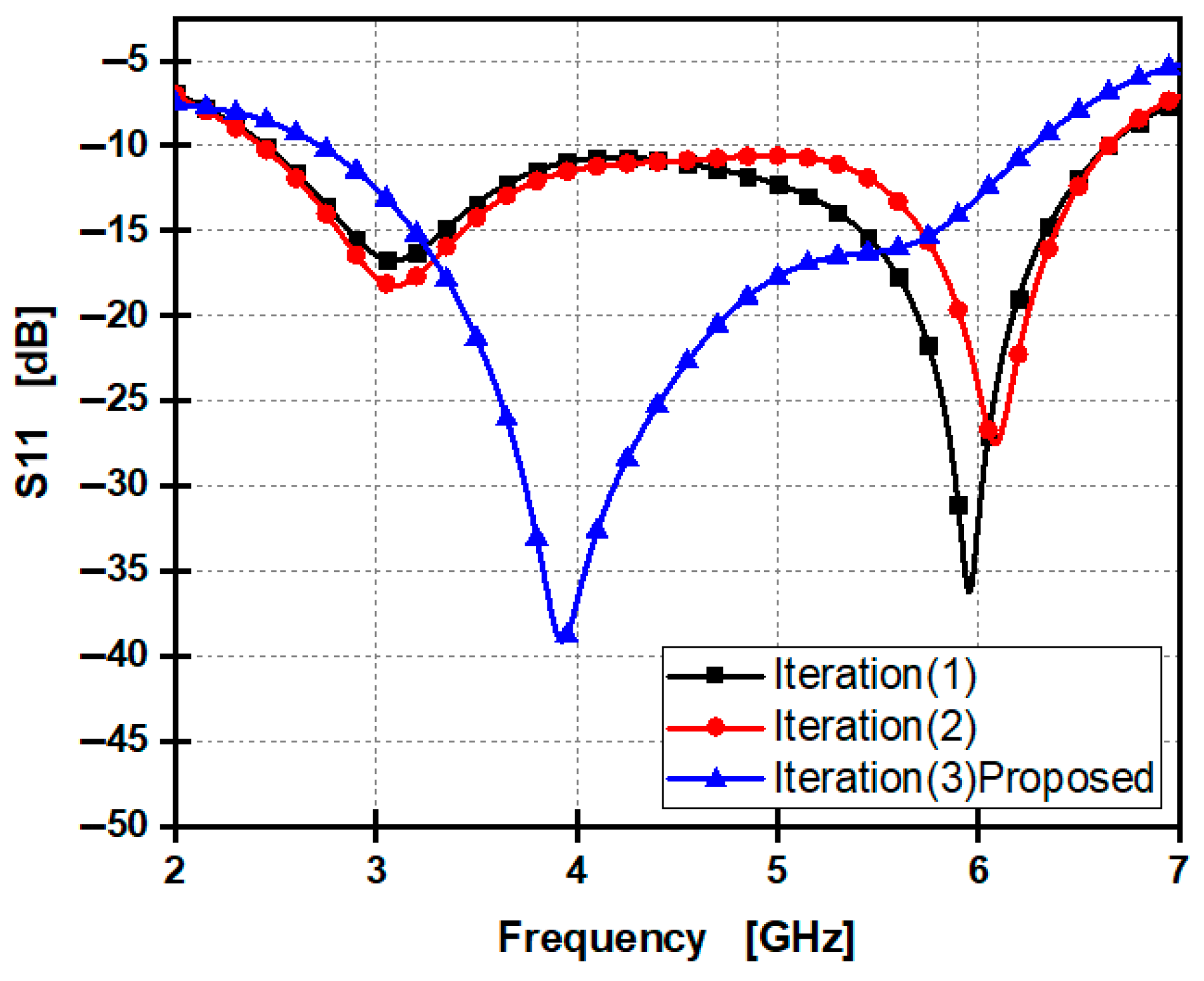

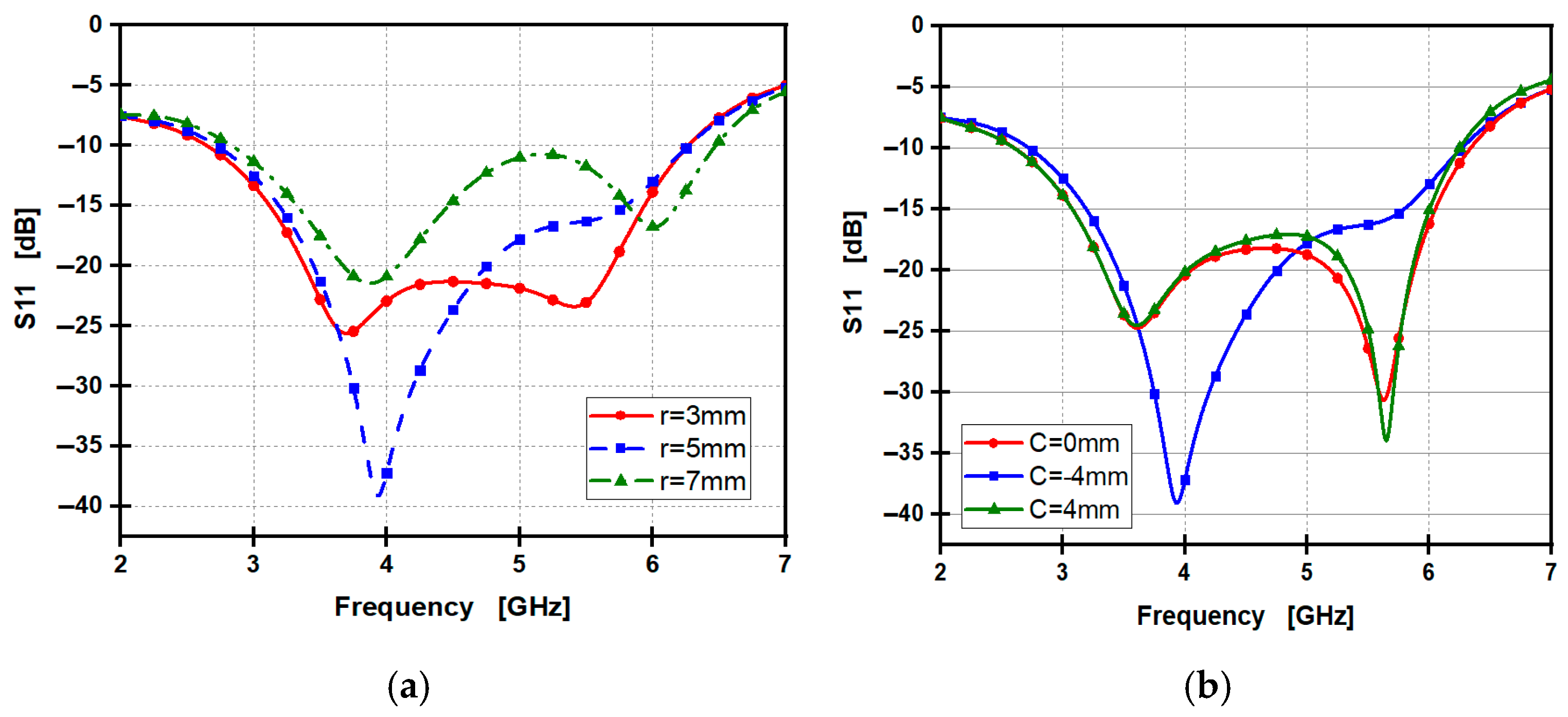
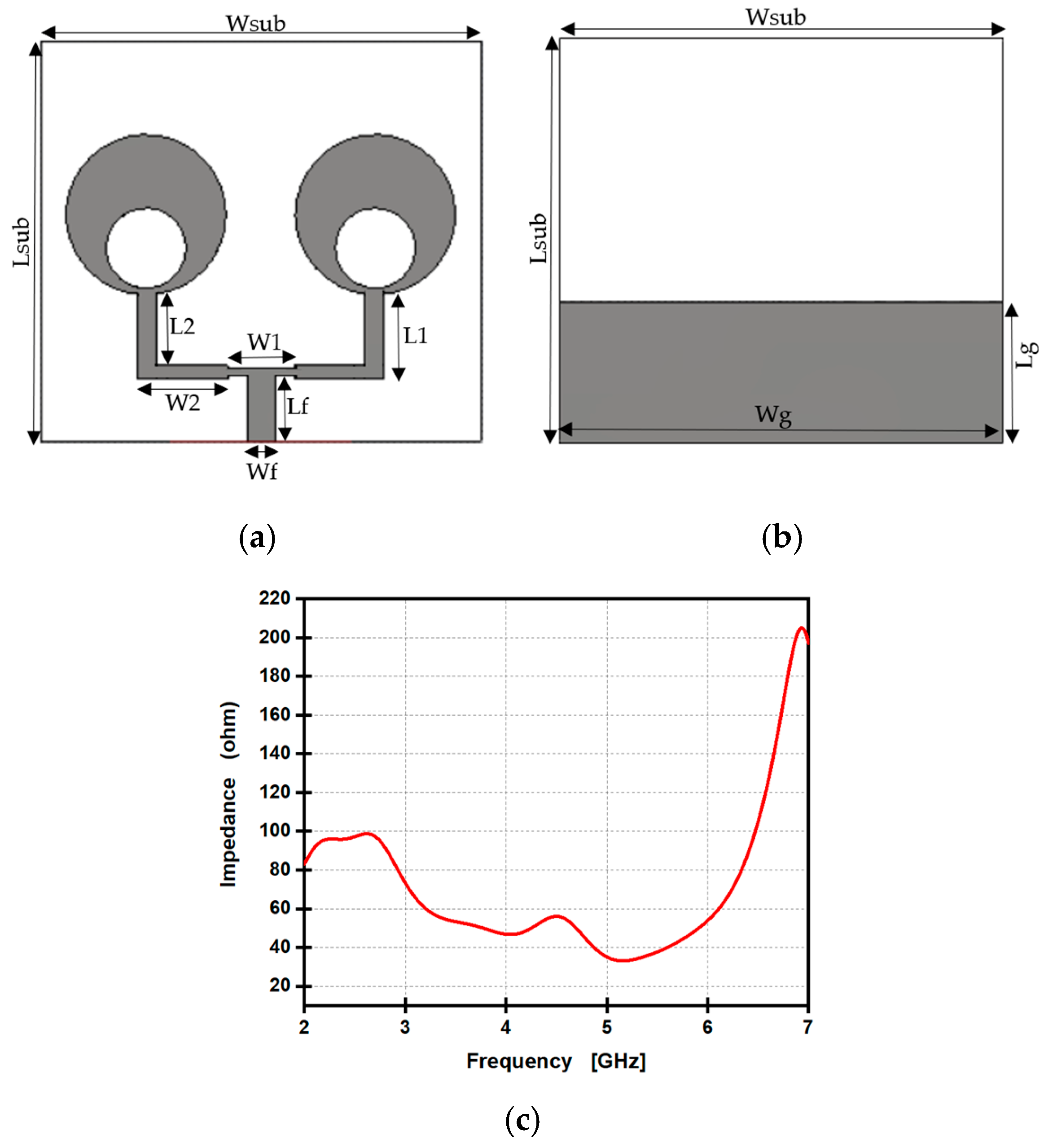

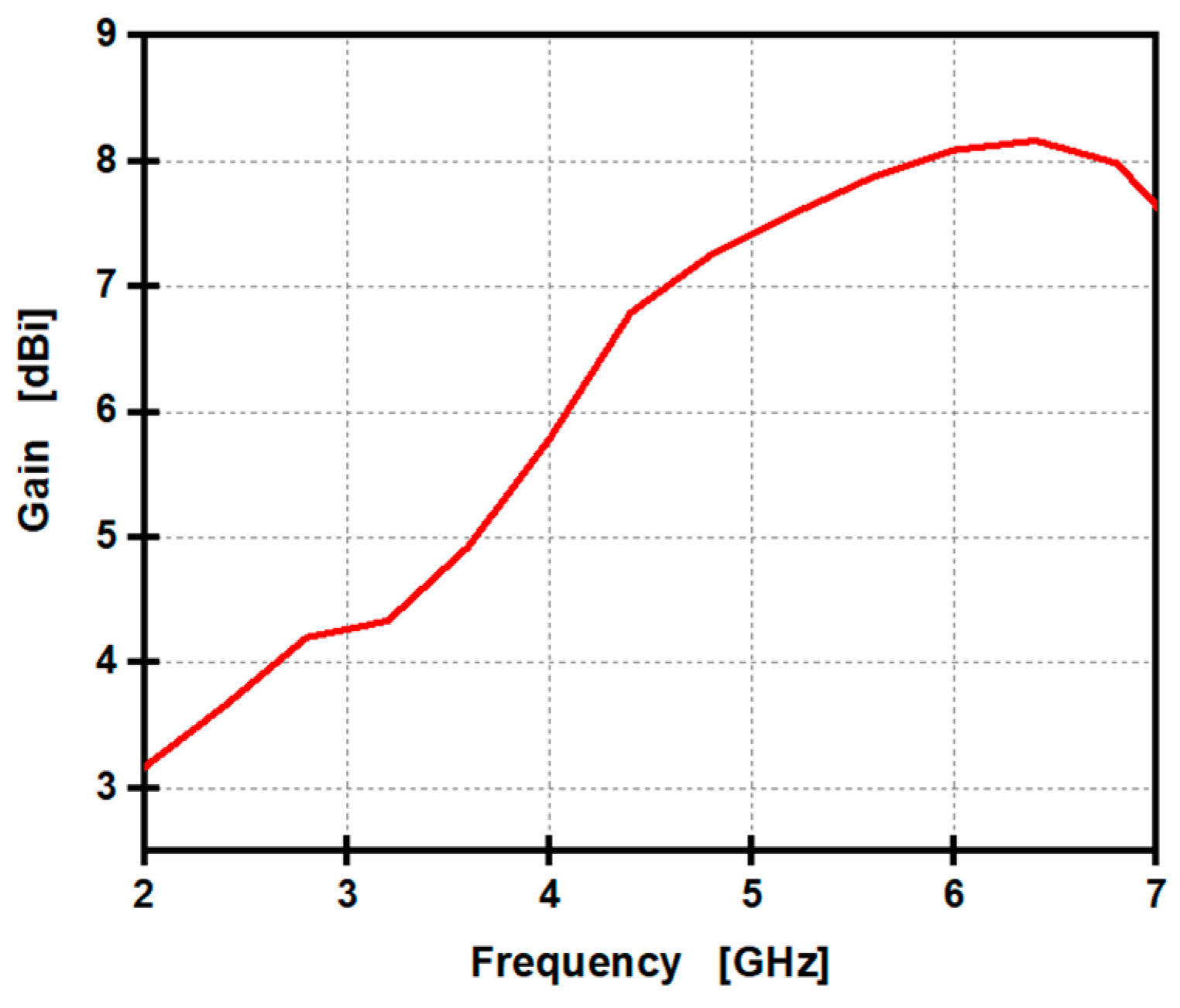
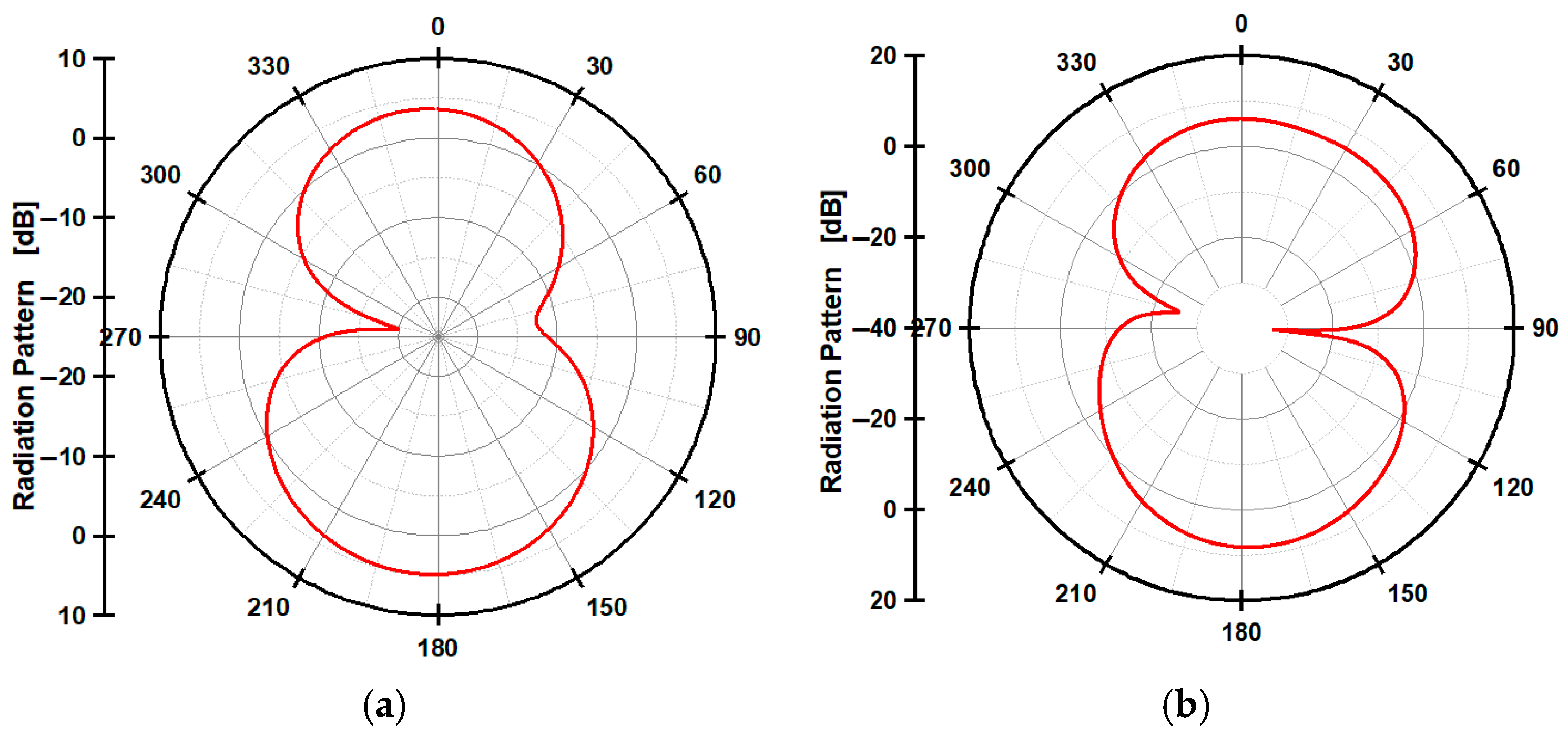
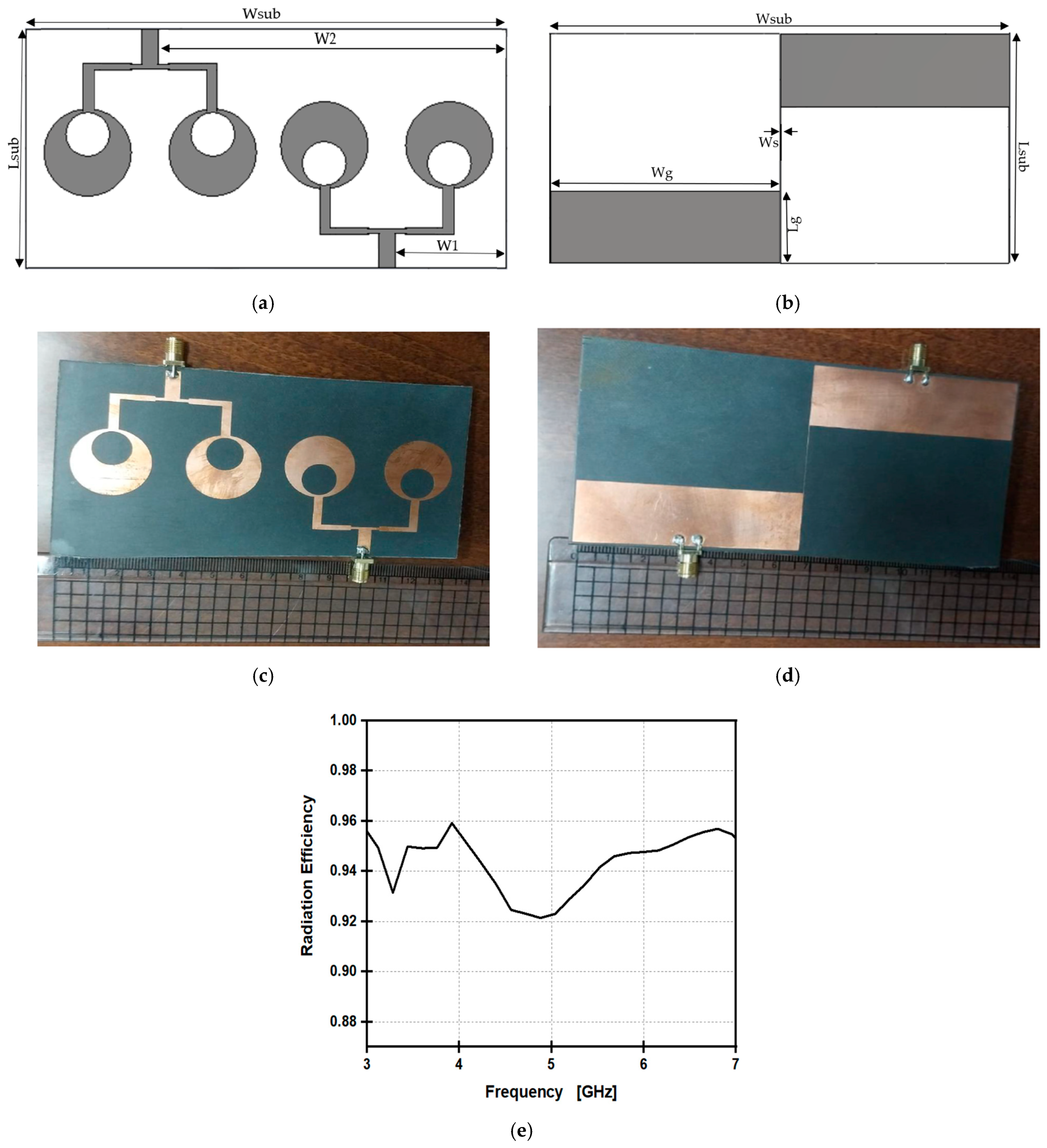
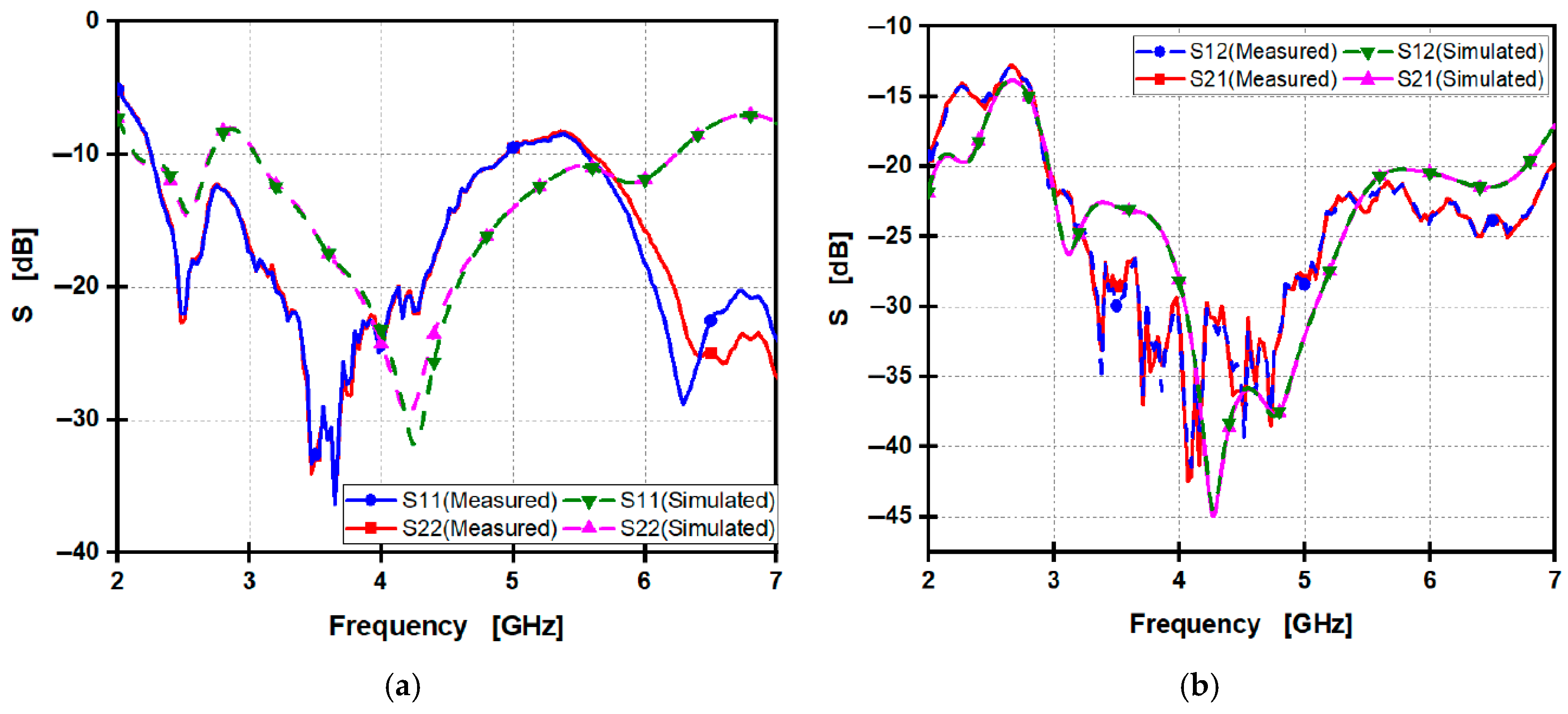



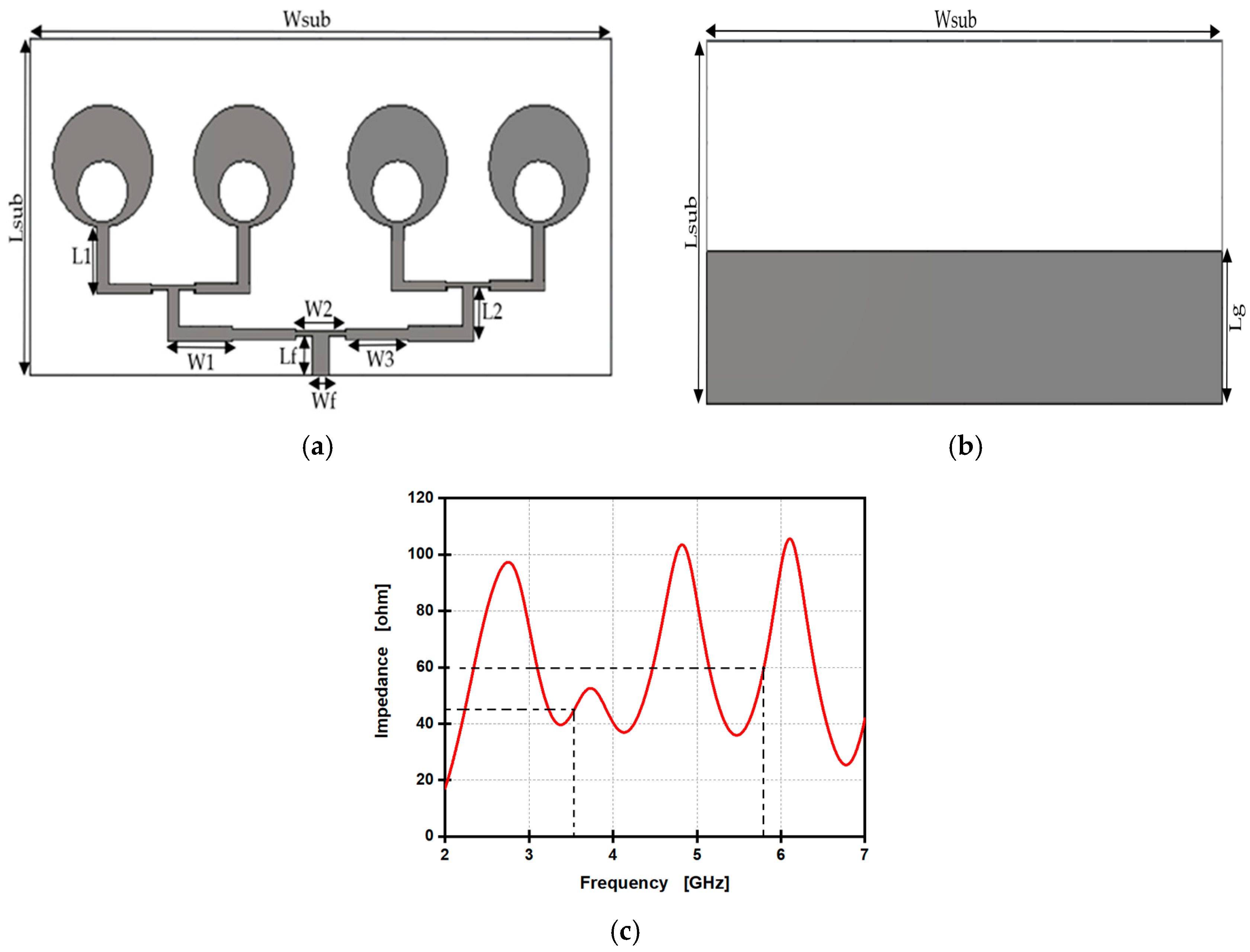
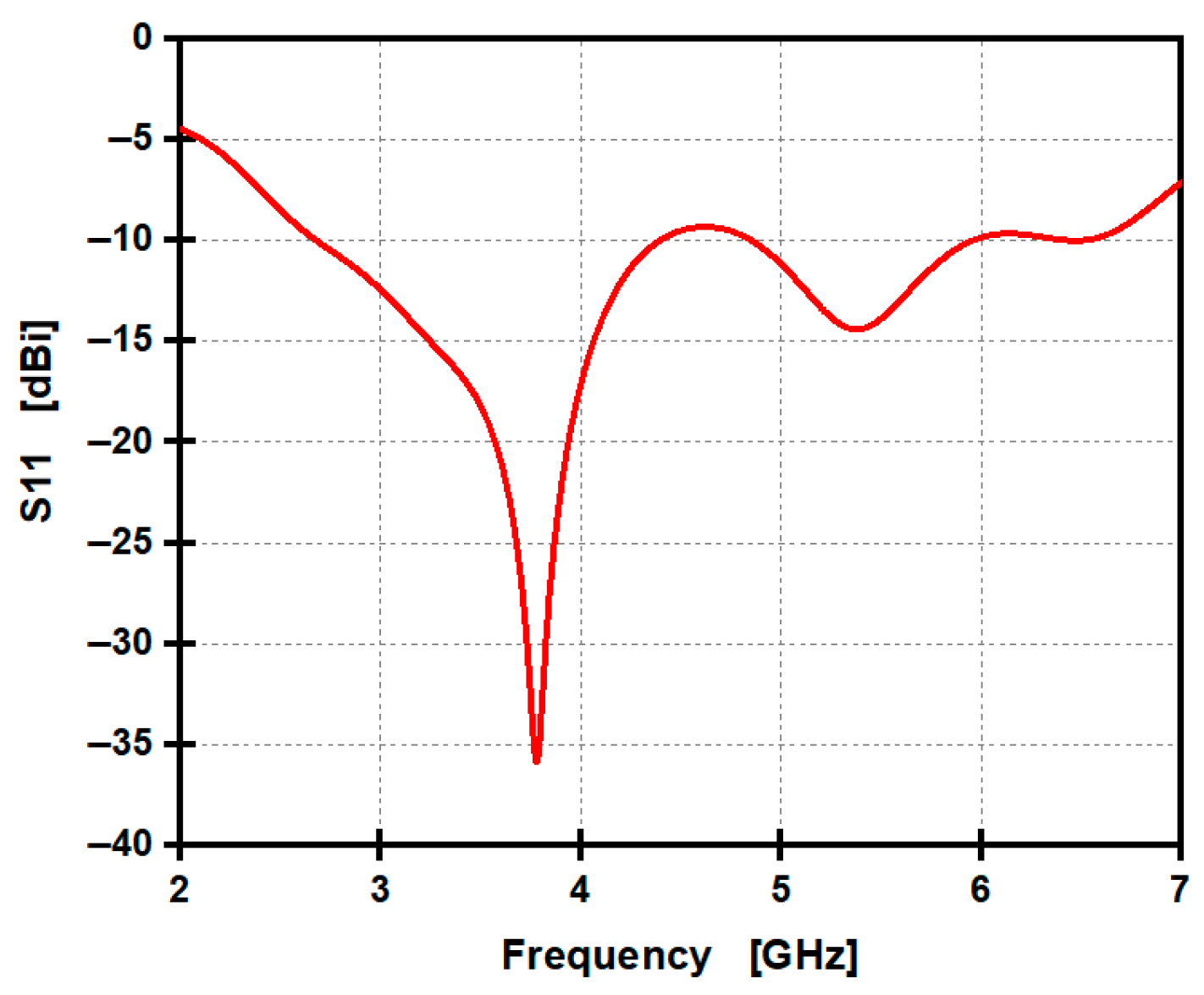
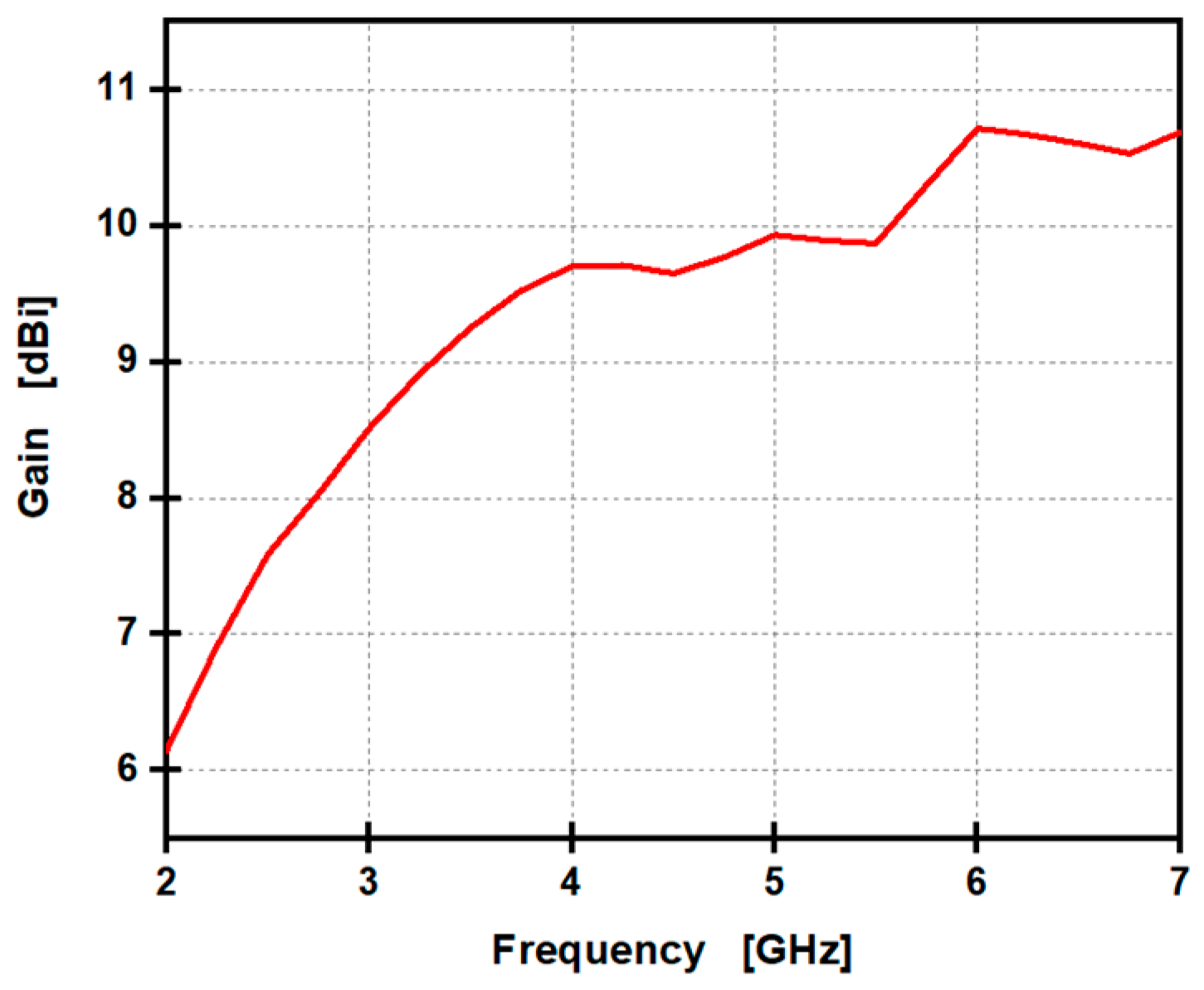
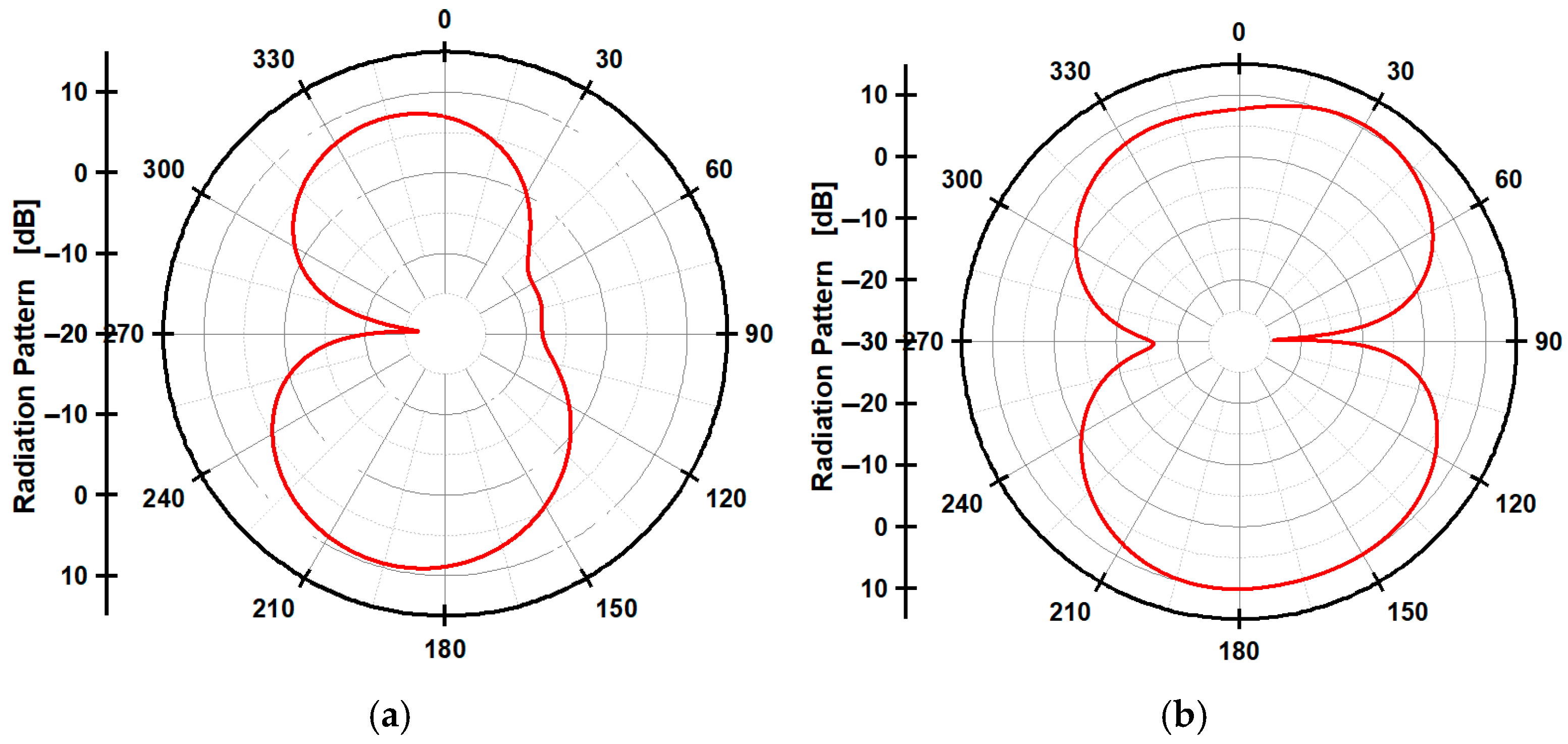

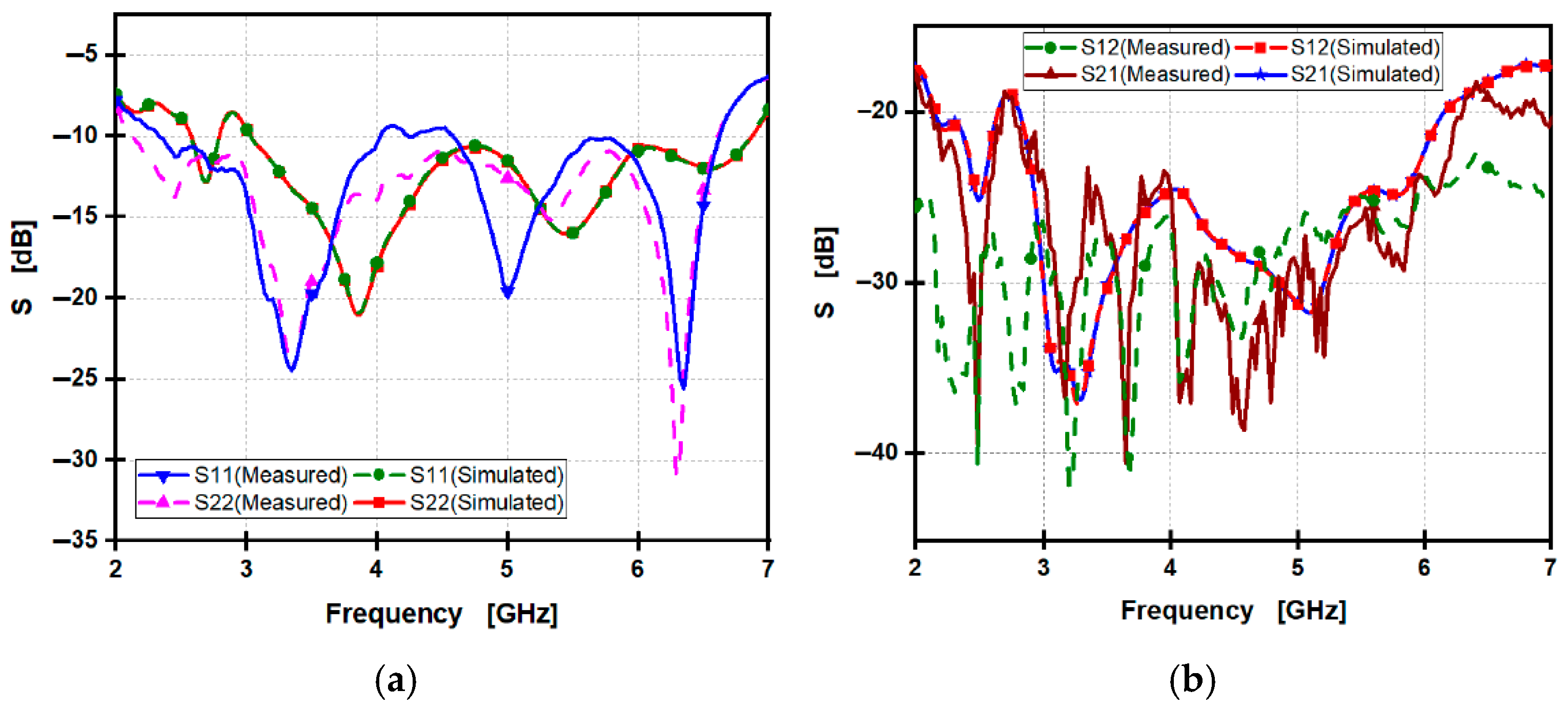
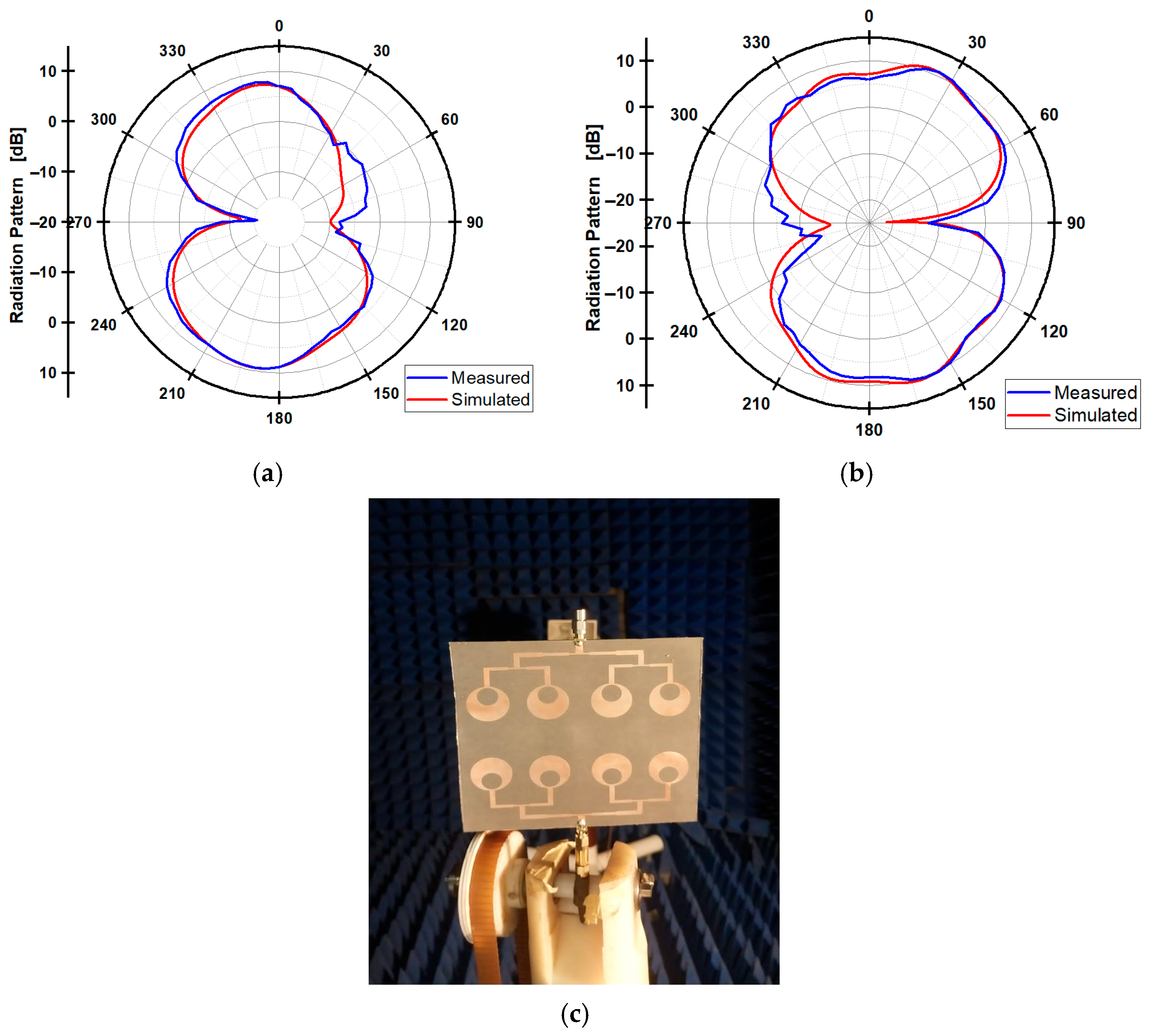
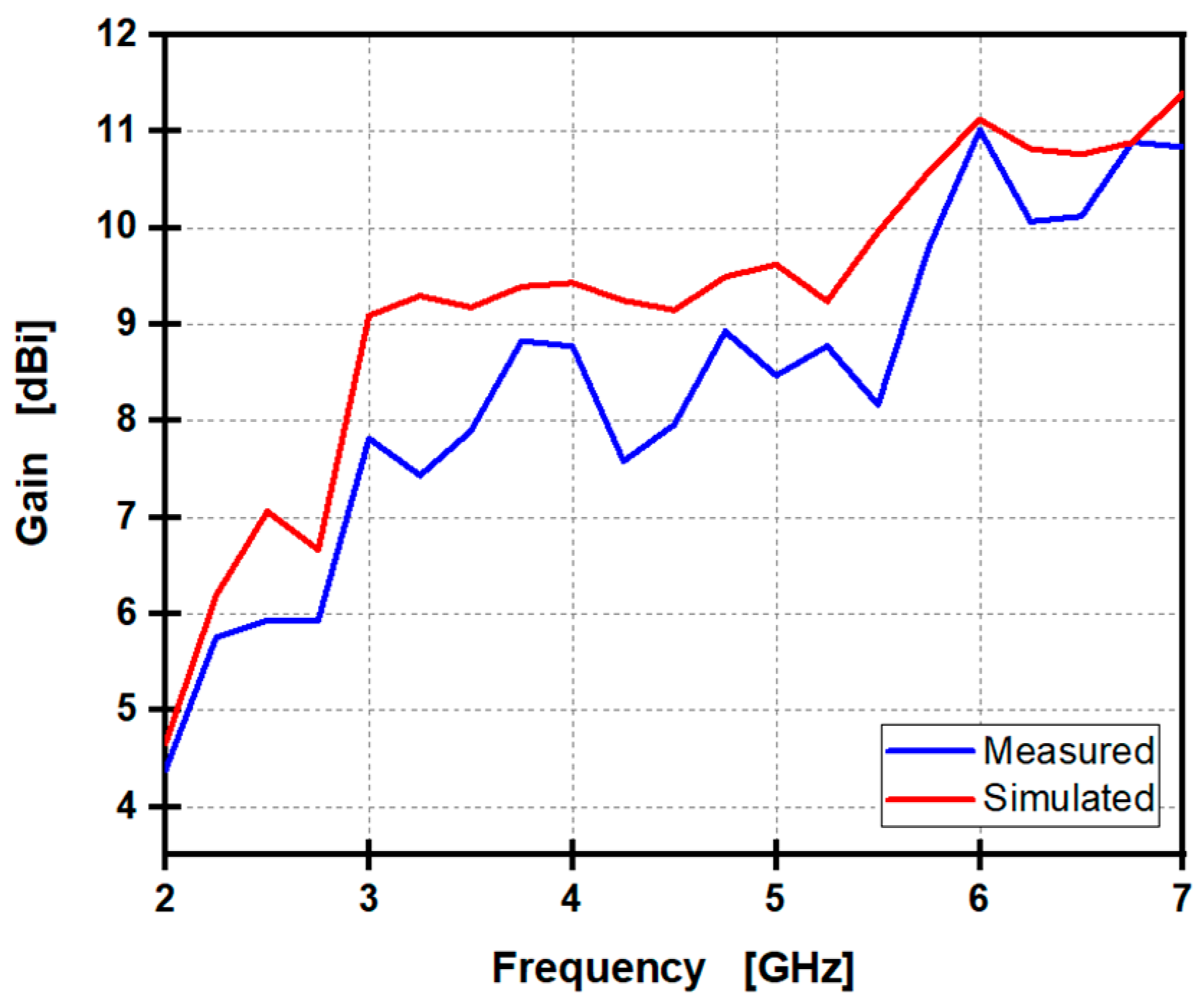

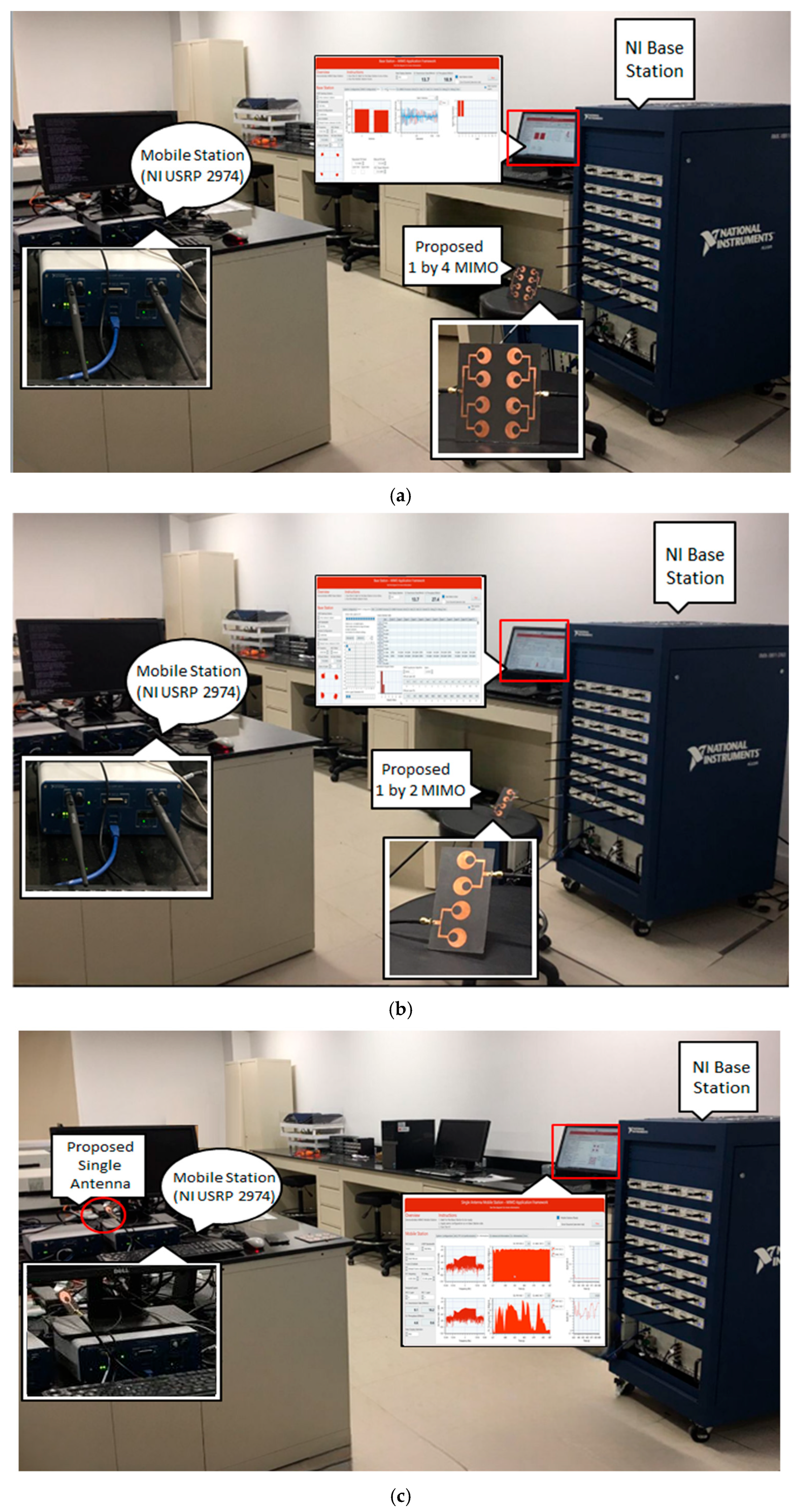

| Parameter | Substrate Width | Substrate Length | r1 | r2 | Lf1 | Lf2 | Wf | c | Wg | Lg |
|---|---|---|---|---|---|---|---|---|---|---|
| (mm) | 30 | 46 | 12 | 5 | 17.35 | 1 | 4.21 | 4 | 30 | 15 |
| Ref. No. | Area | Bandwidth | Max Gain | Max Efficiency % |
|---|---|---|---|---|
| [30] | 50 × 50 | 2.89–4.07 5.1–6.19 | 2.6 | - |
| [31] | 30 × 29 | 2.38–2.77 | 1.42 | 74 |
| [32] | 40 × 40 | 2.36–2.74 | 0.74 | 46 |
| 5.14–6.18 | 2.3 | |||
| Proposed single antenna | 30 × 46 | 2.96–7.1 | 4.3 | 84 |
| Parameter | Substrate Width | Substrate Length | Wf | LF | W1 | W2 | L1 | L2 | Wg | Lg |
|---|---|---|---|---|---|---|---|---|---|---|
| (mm) | 66 | 60 | 4.21 | 10 | 10 | 13.04 | 13 | 11 | 66 | 20.89 |
| Parameter | Substrate Width | Substrate Length | W1 | W2 | Wg | Ws | Lg |
|---|---|---|---|---|---|---|---|
| (mm) | 132 | 66 | 30.73 | 96.69 | 66 | 0.1 | 20.89 |
| Ref. No. | Size | Bandwidth | Max Gain | Max Efficiency % | ECC |
|---|---|---|---|---|---|
| [27] | 85 × 97.73 × 1.6 | 3.43–3.9 4.61–4.99 | 6.56 | 70 | - |
| [36] | 160 × 75 × 7.5 | 3.4–3.6 | - | >55 | <0.1 |
| [37] | 150 × 75 × 7.8 | 3.3–3.6 | - | 60 | <0.31 |
| [38] | 150 × 75 × 7 | 3.1–6 | 5.8 | 65 | <0.02 |
| [39] | 95 × 65 × 0.2 | 3.05–3.07 | 2.2 | - | <0.1 |
| Proposed MIMO of two 1 × 2 arrays | 132 × 66 × 1.57 | 2.27–4.94 5.53–7.84 | 8.3 | 95 | <0.006 |
| Parameter | Substrate Width | Substrate Length | Wf | LF | W1 | W2 | W3 | L1 | L2 | Lg |
|---|---|---|---|---|---|---|---|---|---|---|
| (mm) | 140 | 66 | 4.21 | 7.72 | 16 | 12 | 15 | 13 | 10 | 27.67 |
| Parameter | Substrate Width | Substrate Length | L1 | L2 | L3 | W1 |
|---|---|---|---|---|---|---|
| (mm) | 140 | 132 | 18.4 | 76.66 | 27.67 | 1 |
| Ref. | Size | Bandwidth | Gain | ECC | SubstrateMaterial | Max Efficiency % | Application | Technique |
|---|---|---|---|---|---|---|---|---|
| [21] | 180 × 180 × 2.7 | 1.68–4.15 | 8.4–9.4 | 0.0005 | Fr-4 | - | 5G | M-shape strip |
| [22] | 150 × 150 × 10 | 3.3–5 | 5.2–6.8 | ˂0.05 | Fr-4 | 84 | 5G | Annular-ring |
| [23] | 129.5 × 129.5 × 28.2 | 1.55–6 | 4–10 | ˂0.5 | - | 84 | 5G | Cavity-backed |
| [24] | 157 × 96 × 1.53 | 2.4–2.5 | 8 | 0.004 | Fr-4 | - | WLAN | Tapered Stub |
| [25] | 110 × 110 × 0.8 | 3.12–3.9 | 7.3 | 0.3 | ROGER RT Duriod | 90 | 5G | Cylindrical DRA |
| [26] | 190.5 × 190.5 × 33 | 1.27–6 | 4–11 | ˂0.1 | R04003C | 82 | WIFI | MIMO |
| [28] | 110 × 110 × 0.787 | 3–5.5 | 5.2–7.8 | - | Fr-4 | - | 5G | Phased array antenna |
| [40] | 135 × 135 × 0.1 | 3.92–5.05 | 3.7 | ˂0.05 | Polyethylene terephthalate (PET) | 74 | 5G | Cavity-backed |
| Proposed MIMO of two 1 × 4 arrays | 140 × 132 × 1.57 | 2.33–4.02 4.25–4.4 4.6–6.62 | 8–10.9 | ˂0.003 | RT5880 | 97.46 | 5G/Sub-6GHz | MIMO-array |
| Parameter | Freq | Channel B. W | LOS | TX Power | Duplexing | Noise Floor |
|---|---|---|---|---|---|---|
| value | 3.5 GHz | 120 MHz | 2.5 m | 0–15 dBm | TDD | 5 dB |
| Parameter | Single Element | MIMO of Two 1 × 2 Arrays | MIMO of Two 1 × 4 Arrays |
|---|---|---|---|
| DL transmission rate (Mbit/s) | 4.6 | 13.7 | 13.7 |
| UL throughput (Mbit/s) | 9.1 | 23.2 | 27.4 |
Disclaimer/Publisher’s Note: The statements, opinions and data contained in all publications are solely those of the individual author(s) and contributor(s) and not of MDPI and/or the editor(s). MDPI and/or the editor(s) disclaim responsibility for any injury to people or property resulting from any ideas, methods, instructions or products referred to in the content. |
© 2025 by the authors. Licensee MDPI, Basel, Switzerland. This article is an open access article distributed under the terms and conditions of the Creative Commons Attribution (CC BY) license (https://creativecommons.org/licenses/by/4.0/).
Share and Cite
Ahmed, H.; Ameen, A.M.; Magdy, A.; Nasser, A.; Abo-Zahhad, M. Slotted Circular-Patch MIMO Antenna for 5G Applications at Sub-6 GHz. Telecom 2025, 6, 53. https://doi.org/10.3390/telecom6030053
Ahmed H, Ameen AM, Magdy A, Nasser A, Abo-Zahhad M. Slotted Circular-Patch MIMO Antenna for 5G Applications at Sub-6 GHz. Telecom. 2025; 6(3):53. https://doi.org/10.3390/telecom6030053
Chicago/Turabian StyleAhmed, Heba, Allam M. Ameen, Ahmed Magdy, Ahmed Nasser, and Mohammed Abo-Zahhad. 2025. "Slotted Circular-Patch MIMO Antenna for 5G Applications at Sub-6 GHz" Telecom 6, no. 3: 53. https://doi.org/10.3390/telecom6030053
APA StyleAhmed, H., Ameen, A. M., Magdy, A., Nasser, A., & Abo-Zahhad, M. (2025). Slotted Circular-Patch MIMO Antenna for 5G Applications at Sub-6 GHz. Telecom, 6(3), 53. https://doi.org/10.3390/telecom6030053








